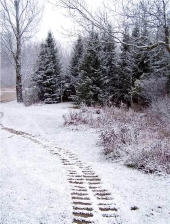posted 16 years ago
On Sunday, I attended an Oklahoma Hunter-Jumper year-end show.
I watched round after round of capable horses & skilled riders comfortably navigating jumping courses of 8 fences at heights of 18 inches to 3', as this was not an "A" rated show.
At "A" shows, fence heights for similar classes average closer to 3' & 3'6" for horses, 2'3" to 3' for ponies. (Horses that are under 14.3 hands are considered to be ponies.)
There were also jumper classes with fence heights of 3'3" to 4' where some of the horses might be considered as "high strung"; but with the influx of breeds considered to be "warmbloods", (these days) you just don't see as many hot blooded Thoroughbreds scrambling around the courses like we did in the 70's. Horses considered to be warmbloods are big bodied (mostly 16 hands & over), solid boned, long strided horses, that appear to be loping to & jumping fences at 5' (on the grand prix level) with great ease.
Average ages of riders range from 8 to beyond 50. The goal in hunter classes is to make it look easy. The horses should be comfortable with their jobs, cantering to the jumps at an even pace, and jumping in a consistent style that demonstrates the horses athletic ability and skill of jumping safely and sanely. Many of the horses at these events have competed for years and are very well suited to the sport. When you have one that competes and wins consistently, year after year, safely teaching riders the sport, you do your very best to care for and maintain that horse. It's not unusual for these horses to compete into their 20's, age wise. Especially when they are cared for properly.
Sometimes, watching round after round of hunter rides can almost be a bit boring (for an audience) if it's done well, because the round should be executed smoothly & as flawless as possible. The judges are looking for conservatively attired riders and horses who behave accordingly.
Horses in the hunter division are expected to be suitable for their riders (if you are too large of a person on too small of a horse, this will count against you, as will too small of a child on a horse who's behavior is deemed unsuitable for that rider's skill level). Of course, all of this scoring and judging is usually left to one person's opinion (the judge), who is responsible for deciding who wins the coveted blue ribbon.
The jumper division is not judged the same way as the hunters & has become increasingly popular. It is also more of a spectator sport. A judge officiates to make sure rules are followed, but the rounds are scored according to the time allowed to navigate the course & jump cleanly (leaving all the fences up), not according to the horses behavior, style or conservative speed. The rails and other equipment used in jumper classes are designed to roll out of the jump cups even if the horse has a light rub. The test is to jump cleanly & quickly. Sometimes, luck happens and a rail is rubbed and stays in the cup. That isn't considered a fault.
I rode for years when I was younger. After moving to Okla. my experience landed me a full time job teaching lessons & riding. I've aged (dang it!) and most of what I do now is behind the scenes, managerial stuff. I still love the sport and have been active in it (in one form or another) for about 35 years. Attached is an old picture (circa 1979) of me showing my beloved horse "The Lifeguard", aka "Artoo". He was an amazing animal. I sold him when I moved to Okla. A trainer and friend who became a judge told me he saw Artoo competing at a show 6 years after I'd sold him. The horse was in his 20's by then.
He was born in 1971, so I'm sure he's no longer with us. R.I.P. Artoo, you were much loved by all who rode you!
artoo.jpg
![Filename: artoo.jpg
Description: [Thumbnail for artoo.jpg]](/t/2482/a/644/thumb-artoo.jpg)


















































 sorry hormonal
sorry hormonal  hugs was such a good boy.
hugs was such a good boy. 



















